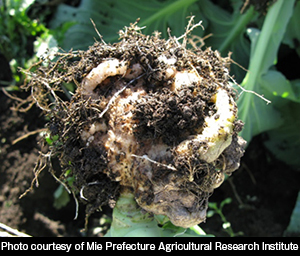Soil Testing
Improving the fertility of soil is essential for growing crops. Soil testing is an important method to know the fertility condition of the soil. Speaking of soil testing, many people think of chemical analyses such as acidity (pH), electrical conductivity (EC), phosphoric acid and nitrogen determination, but in addition to these tests, physical and biological analysis can be also performed and considered very effective.
Various organisms are active in the soil, and there may be a mixture of things that causes plant disease. Therefore, the biological test to check if the cause of the plant disease exists in the soil is very effective to prevent the plant disease.
Nippon Gene Material provides a biological analysis service by genetic testing for your quick outcome for soil condition.
Example: Clubroot

- What is it: Diseases peculiar to cruciferous plants
- What characteristics: Disperses in soil and survives for years
- What can we do: Check the density of pathogenic bacteria in the soil to apply the optimal control method
Clubroot is a plant disease peculiar to cruciferous plants and is a soil-borne disease that is difficult to control once plant develop it. When infected with clubroot, many small and large bumps form in the roots. Absorption of water and nutrients from the soil is hindered, and the stems and leaves will wither during sunny days. Delayed growth causes the leaf color to fade and the quality of the harvest decreases.
The pathogen (Plasmodiophora brassicae) is a type of mold that exists in the gall of the roots. If the gall rots, it will disperse in the soil and survive without the host plant for more than 4 years, sometimes more than 10 years. For this reason, once a field has been corrupted by infection, damage may occur over a long period of time, and it often spreads from the infected field to the surrounding area due to soil movement or rain during farming.
When judging the application of fungicides as a countermeasure for clubroot, it is effective to know the bacterial density in the soil in advance.
Detection Kit
DryADD™ Clubroot Disease Detection LAMP kit
A diagnostic kit for measuring the density of Plasmodiophora brassicae by yourself.
The product name has been changed from former “Clubroot disease detection kit (LAMP Dry reagents)”, while there is no change in the product content.
* The linked page may be in Japanese, please use the translation function of the browser.
Detection Service
Plasmodiophora Quantification (Clubroot Testing) Service
A service to measure the density of Plasmodiophora brassicae from the soil that you provide.
* The linked page may be in Japanese, please use the translation function of the browser.
Soil nematode
- What is it: Also called “roundworm”, many types of nematodes present in soil
- What characteristics: “Plant parasitic nematodes” damages crops
- What can we do: Characterize the type of nematodes in the soil in order to apply the optimal control method
There are many types of nematodes in the soil. While there are nematodes which decompose bacteria, mold, spoilage organic matter, etc. in the soil and do not affect our lives, there are also “plant parasitic nematodes” in the soil that infest plants and damage crops.
Nippon Gene Material provides a testing service which detects and discriminates almost all of the plant parasitic nematodes “root lesion nematode” (9 species) and “root knot nematode” (4 species) distributed in fields.
Detectable nematode species
Pratylenchus sp. (root lesion nematode) 9 species
・P. coffeae
・P. kumamotoensis
・P. neglectus
・P. pseudocoffeae
・P. crenatus
・P. zeae
・P. loosi
・P. penetrans
・P. vulnus
Meloidogyne sp. (root knot nematode) 4 species
・M. arenaria
・M. hapla
・M. incognita
・M. javanica
Detection Service
Soil Nematode Detection Service
A service to check the presence of plant parasitic nematodes from the soil that you provide.
* The linked page may be in Japanese, please use the translation function of the browser.




